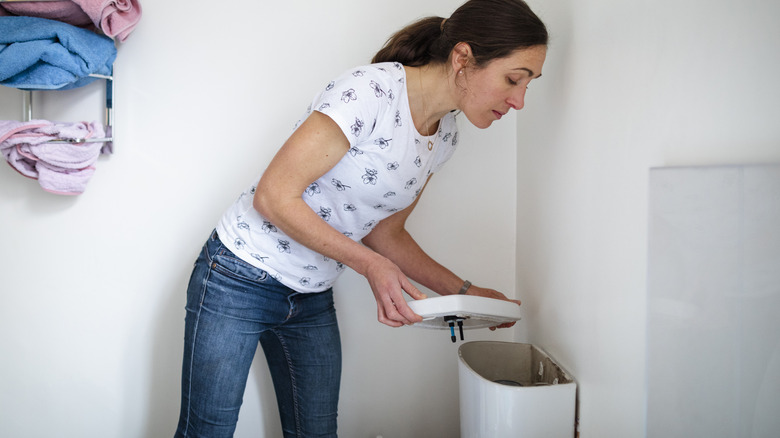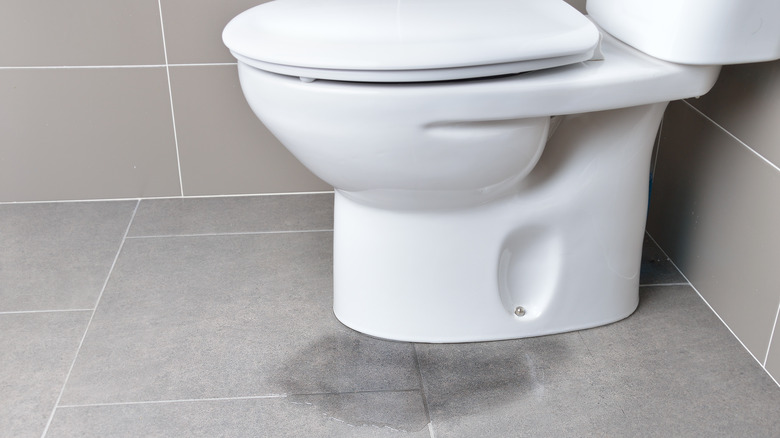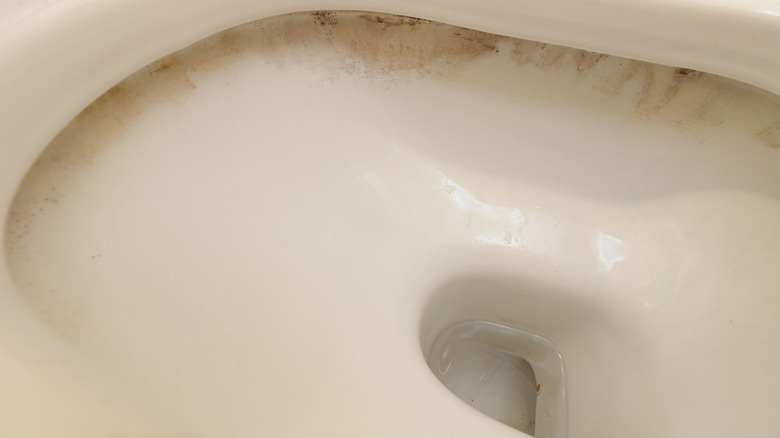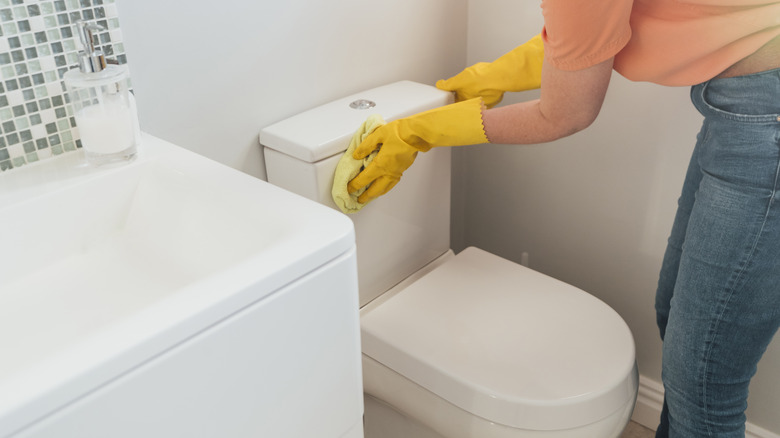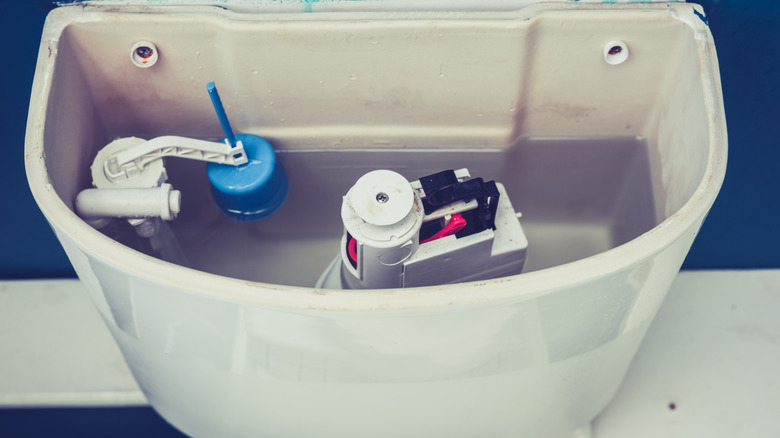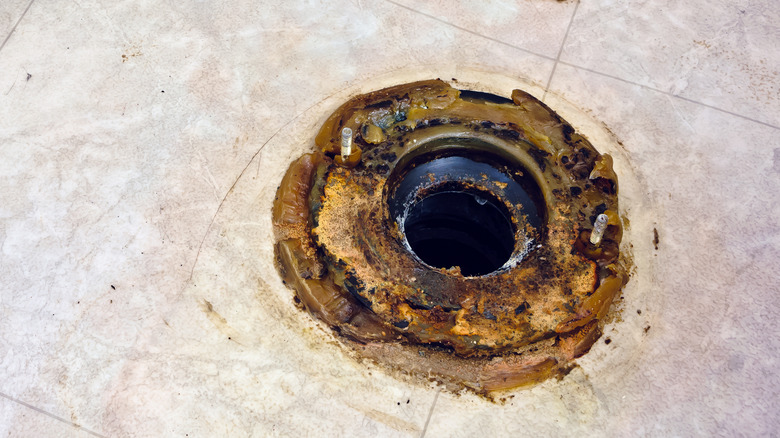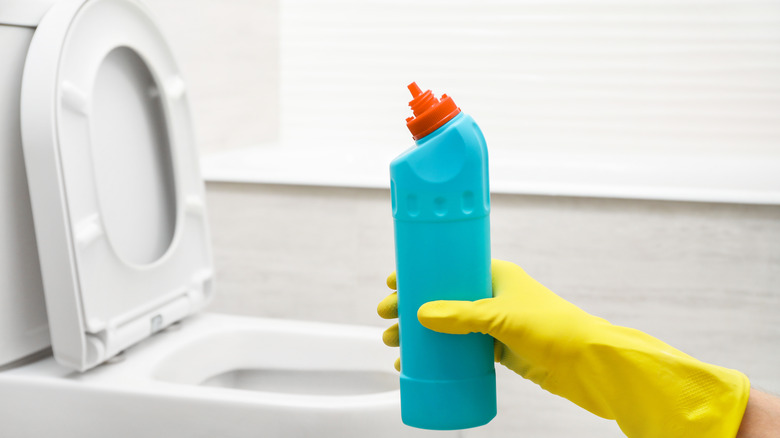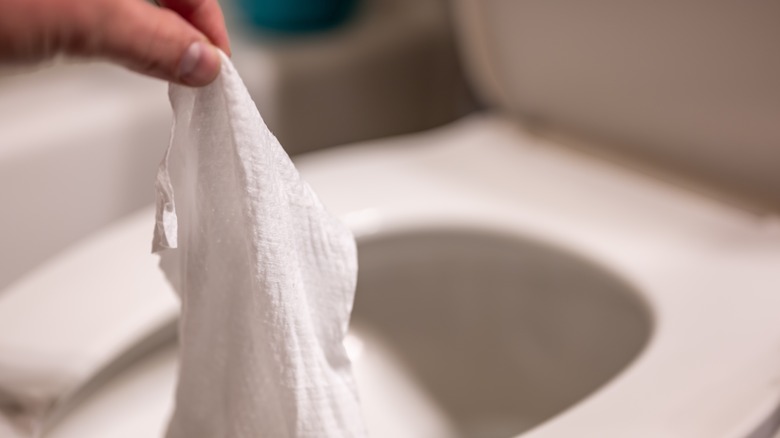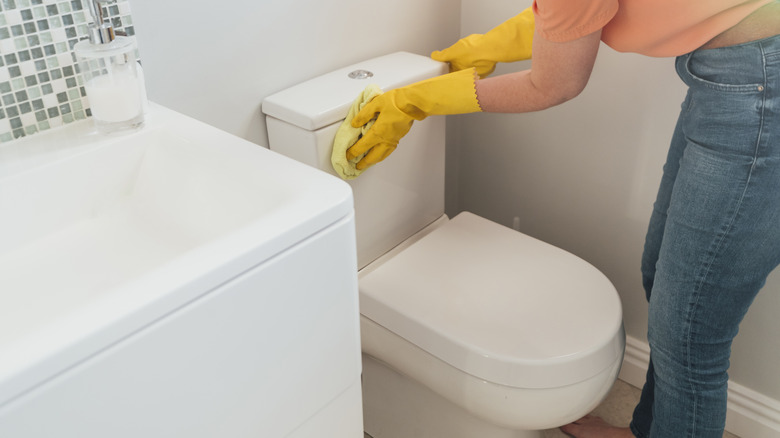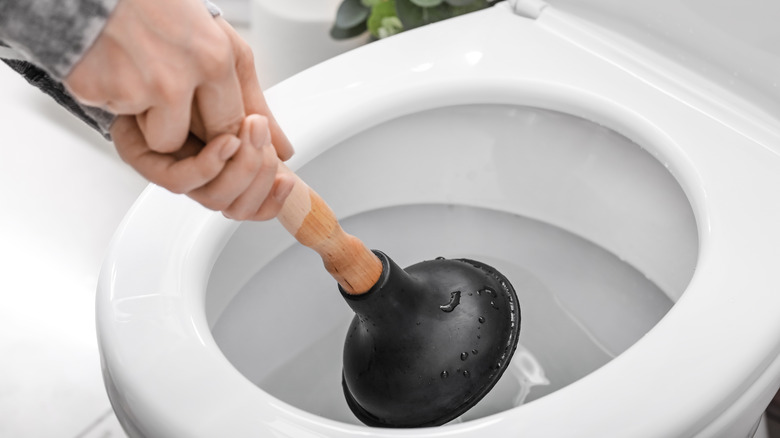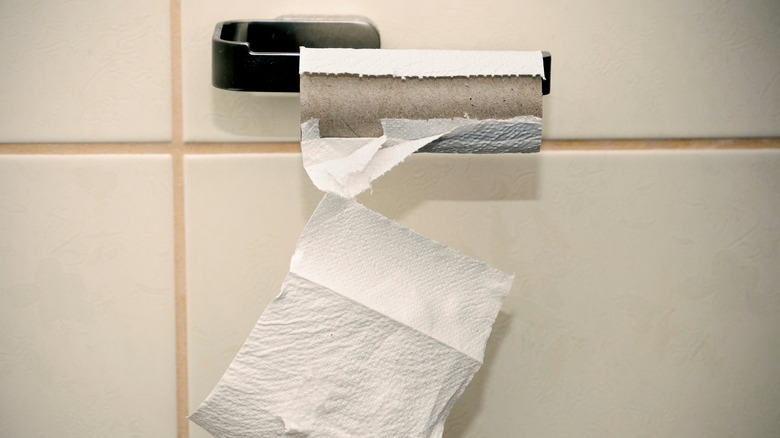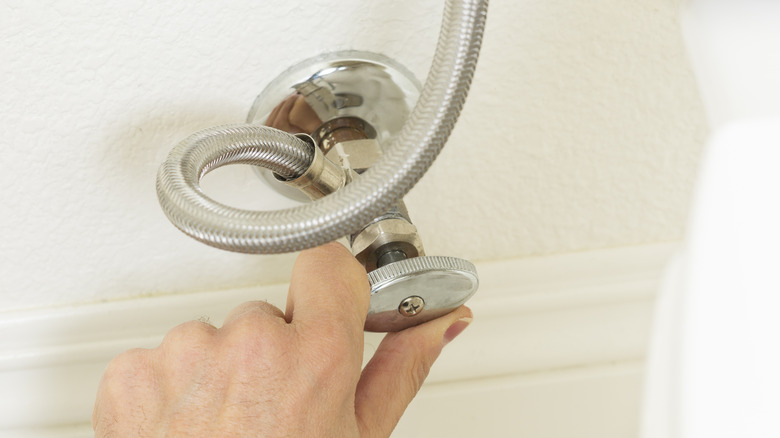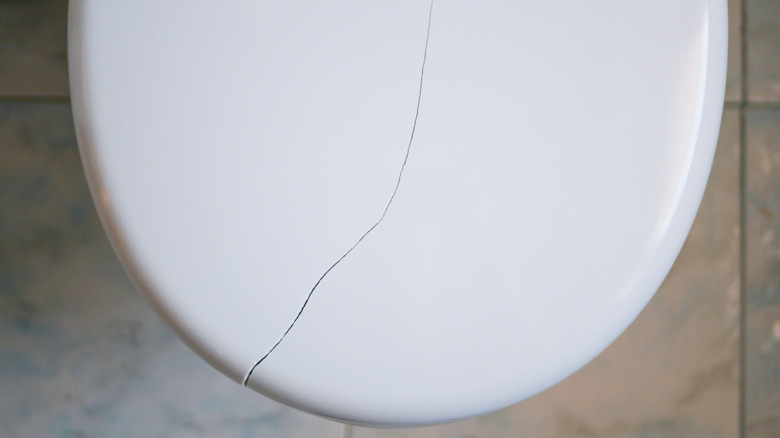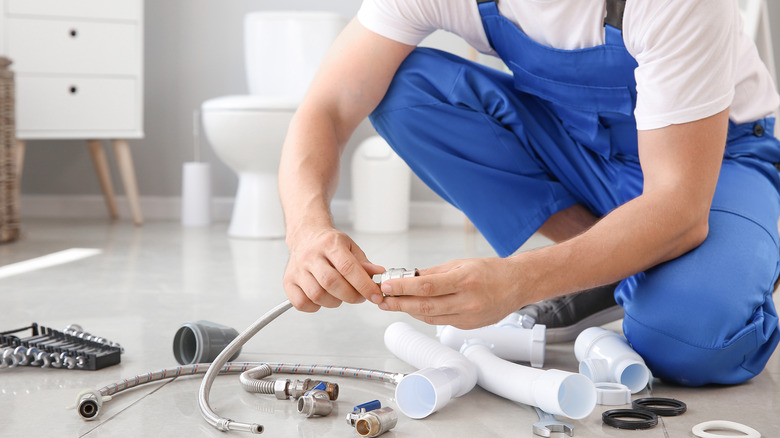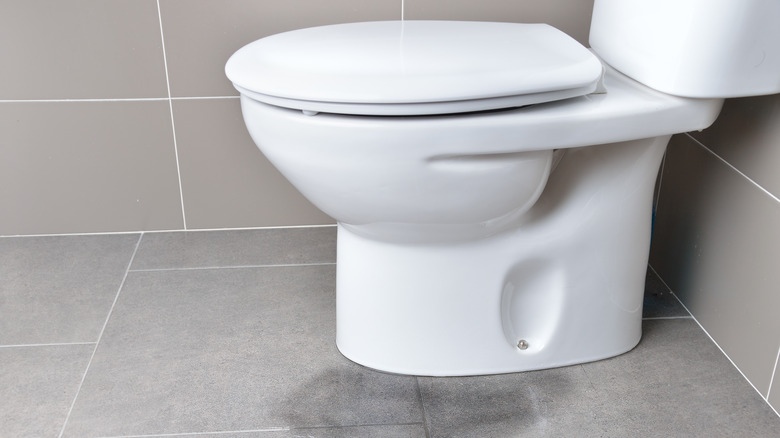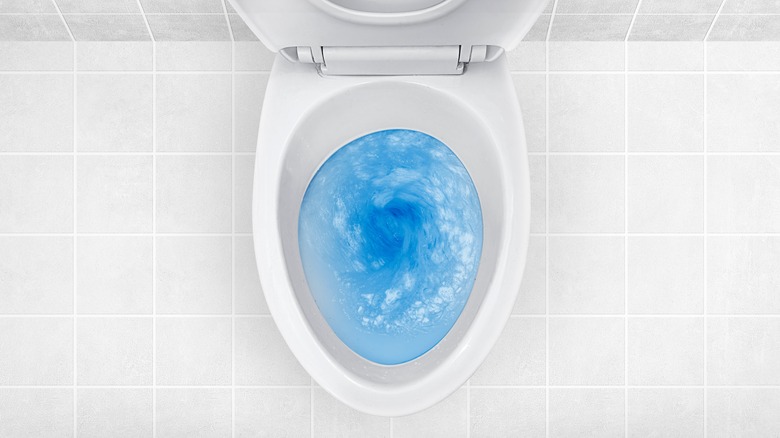Maintenance Tips That'll Keep Your Toilet In Tip-Top Shape
Toilets can be exposed to a lot of heavy use, and since they're expensive to repair or replace, it makes sense to look after them. Although caring for your toilet probably isn't the most glamorous job on your checklist, it's one that you certainly shouldn't avoid. Proper maintenance of a toilet can significantly increase the expected lifespan of this bathroom workhorse, which can save you money and inconvenience in the long run.
Some of the most common problems homeowners experience in their bathrooms include blocked and leaking toilets. These can be incredibly disruptive to the daily running of your household, and downright unpleasant to deal with. The fear of the toilet overflowing as a result of blocked pipes is something that many people struggle with. Barry Jacobs, senior vice president of product development at Flush Guard Industries, tells Business Wire, "Our research shows that 'Overflowbia,' or the fear of a toilet overflow, is very real — particularly among those who have experienced it firsthand." Fortunately, there are some simple ways you can maintain your toilet to keep it working as it should for as long as possible.
Look for leaks
Bathroom leaks aren't always easy to spot. "Many people may not realize they have a leak in their toilet because it does not look like a pool of water on your bathroom floor," Tom Reynolds, CEO of the Bathroom Manufacturers Association (BMA), explains to Which. More commonly, toilet leaks aren't usually identified until they've caused considerable harm to the home, such as ceiling water damage on the floor below. Reynolds recommends that "routine maintenance will help prevent leaks," saving the homeowner costly repairs.
To check for leaks within your toilet, look for ripples in the water in the bowl every week. This is a key indicator that your toilet won't stop leaking, which can waste gallons of water in a single day. You could alternatively put food dye in your toilet tank, and if the color of the water starts to fade without flushing it, then you know you have a leak. Knowing how to properly check for leaks, and being aware of how often to carry out these checks, can save water and improve the longevity of your toilet.
Use a water softener
Areas with hard water are prone to limescale buildup, and this buildup attracts bacteria and dirt residue. These factors combined can cause the narrowing of pipes, which in turn can play a part in toilet blockages. Limescale also leaves an unattractive residue on the inside of the bowl, giving your toilet an unsightly appearance. Water-softening solutions can prevent limescale from forming, eliminating these potential issues.
A low-cost and fuss-free way to eliminate limescale in toilets is the use of soft water or anti-limescale tablets. These tablets can be placed in the toilet tank, and they will remove the minerals in the water that cause limescale before it is flushed into the bowl. A great ingredient for combating limescale that you probably already have at home is white vinegar. When you put vinegar in your toilet, spray the inside of your bowl and leave it to work overnight before flushing away. This will help remove and prevent limescale build-up.
Clean thoroughly and regularly
Cleaning the bathroom, and most specifically the toilet, is one chore that many people detest doing. You might be disappointed to learn that the recommended schedule for disinfecting this piece of bathroom equipment is once a week at a minimum. This benefits the health of anyone using the bathroom because E.coli thrives in and around the area where the toilet is installed. Regular cleaning can also prevent common issues that can cause your toilet to keep clogging.
First, disinfect the bowl by generously applying a product like Method's Antibac from Grove, then use a toilet brush to attack any stubborn stains. You should also scrub beneath the toilet rim to ensure the holes are clear where flushing water comes out. This will also help to keep your flush operating at full force. The outside of the toilet should not be forgotten. Use rubber gloves to protect your hands and disinfectant wipes to cleanse the outside of the toilet, including the lid, the seat, the tank, the handle, and the outside of the bowl.
Maintain correct water level
Keeping the water in a toilet tank at just the right level can prevent numerous issues with the toilet. When the water level is too high this can cause the toilet to run constantly or make an annoying hissing noise when it refills. When the water level is too low, you will experience a weak flush, which can cause pipe blockage problems.
Incorporating a quick check of the tank water level into your bathroom maintenance routine will help keep any potential issues from developing. To check the water level remove the lid from the tank and then flush the toilet. Observe the water as it refills. Check the level of the water once the tank has finished filling. It should not be any higher than the overflow tube, but it should also fill the tank to within an inch of the top of it. If the water level is too high or too low you should consult your toilet manual for directions on how to adjust this.
Don't ignore odors
You might think unpleasant odors are to be expected in the bathroom, but if you notice a nasty smell even after a thorough clean this can be a sign that something is wrong. Bad odors are a common toilet problem you shouldn't ignore since they often indicate that the wax ring seal beneath the toilet needs to be replaced. This seal prevents odors from the sewer from making their way into the bathroom. So it's essential to get this checked out if your nose detects something stinky.
If you suspect the wax ring needs to be assessed you will need to remove the toilet itself. This can be quite a tricky job, so you should only tackle it yourself if you know how to remove and reinstall a toilet. Otherwise, it will be necessary to call a professional for help. The cost of replacing a wax seal is typically between $50 and $150 but a fresh-smelling bathroom is priceless.
Avoid harsh chemicals
Some clog removers contain harsh chemicals that can damage your pipes and the internal parts of your toilet. Despite your best intentions, this can cause a whole host of problems down the line and negatively impact the lifespan of your toilet. Avoiding the use of harsh chemicals will eliminate this issue and cause less harm to the environment.
Natural cleaning products can work just as well as chemical cleaners. To address blockages, pour a few cups of vinegar into the bowl. Next, watch as the magic happens when you add baking soda to the toilet. These two natural ingredients create a ferocious fizz that can break up clogs while the abrasive quality of baking soda can also work to remove grime from the inner walls of the toilet. Boiling water can be used with baking soda to tackle toilet clogs if you don't have any vinegar on hand.
Know what not to flush
This should go without saying, but a toilet is not a trash can. Unfortunately, many products are labeled as 'flushable' when they should not be put in the toilet and this can cause a lot of confusion. If you're in a home with an older toilet and pipe system it's especially important to avoid putting anything down the toilet that doesn't belong there because these typically clog more easily.
To flush or not to flush? That is the question! The best advice is to avoid putting anything down the toilet except for human waste and toilet paper. Some people flush wet wipes down the toilet because of their similarity to toilet paper, but these will not disintegrate in the same way as toilet paper and may cause issues. Don't be misled by claims from flushable wipes companies that their products can be disposed of in the toilet. They cannot disintegrate as quickly as toilet paper and can result in blocked pipes. Other things you should never flush down the toilet include feminine hygiene products, tissues, cotton pads, hair, cigarette butts, gum, dental floss, condoms, and paper towels.
Keep it dry
As a fixture in the bathroom, it's no surprise that the outside of a toilet often gets wet. Condensation and splashes from the bathtub or shower are common causes of a wet toilet. If moisture sits on the exterior of the toilet for too long it can cause rust and corrosion. This can result in a breaking down of the structural integrity of the fixture which could lead to leaks and it also makes for an unpleasant appearance.
To keep your toilet looking its best and working the way it should, aim to remove any moisture from the exterior as soon as you spot it. Try to wipe down the toilet with a cloth each time you shower, or try to prevent moisture build-up by improving ventilation in the bathroom. If your toilet is sweating this is usually a result of the water in the tank being cooler than the air in the bathroom. This can also cause issues with rust and corrosion, so if it is happening consistently you could address it by installing a dehumidifier in the bathroom.
Pay attention to draining
A slow-draining toilet is a symptom of an underlying problem. It's tempting to ignore a toilet that drains slowly if it isn't affecting your ability to use the bathroom, but doing so could make the issue more tricky (and expensive!) to resolve. Common problems that slow-draining toilets point to are mineral deposit build-up, a blocked pipe, low water levels, or an ineffective flushing mechanism.
If you notice a slow-draining toilet you should investigate the cause before the problem worsens. When the toilet is slow to drain after flushing this usually indicates a problem such as a clog in the toilet or a blockage in the pipes. If the toilet is slow to fill up after flushing this is more likely an issue with the tank. The way you address the problem depends on what the problem is. You could resolve a blockage with a plunger or drain snake or try to break down the clog with natural products. For a slow-filling toilet, turn off the water and look into your toilet tank. From here, empty the water from the tank and then adjust the float level to improve the flushing power. If you can't fix a slow-draining toilet with DIY methods, it might be time to call a professional.
Don't use too much toilet paper
Excessive use of toilet paper can cause blocked pipes in the bathroom. Toilet paper is designed to disintegrate quickly in water but if it clumps together it can jam up the toilet and cause a clog. Toilet paper blockages are easy to prevent. Be sure to educate the members of your household on how much toilet paper they should be using, and offer reminders to young children who are just learning the rules of the bathroom.
You could also consider making the switch to bamboo toilet paper. Bamboo toilet paper breaks down more easily than regular toilet paper so this could be a solution if your toilet is especially prone to blockages. It is also stronger and more absorbent, so fewer sheets are needed per use. As a bonus, bamboo toilet paper is also better for the environment, it's cost-effective, and it's compatible with septic tanks.
Test the shut-off valve
The function of the shut-off valve is to stop the flow of water. This is vital in the event of an overflow issue or a bad leak to prevent water damage or a flood in the bathroom. If the shut-off valve is broken this can cause big problems in an emergency. Unfortunately, this part of a toilet is used so rarely that many people won't realize it's broken until they need it. And, of course, by that time it's too late.
It's good practice to test the toilet shut-off valve is working every six months. First, you need to locate it. It's usually positioned behind the toilet or below it. Next, turn the valve as far left as it will go. It might be stiff at first and if that's the case turn it back and forth to loosen it up. Once the valve is fully turned, you can flush the toilet and observe if any water comes out. No water means the shut-off valve is working properly. If water does flush into your toilet bowl the shut-off valve hasn't worked and needs replaced.
Don't stand on it
Toilets are seemingly strong and stable so it's tempting to stand on them if you need to reach a high shelf or dust the ceiling in the bathroom. However, if you want to keep your toilet in good shape, this is a practice you should certainly avoid. Standing on a toilet can damage the integrity of the entire fixture. You could cause the lid or seat to crack, or the whole toilet could come away from the wall. You might think that allowing small children to stand on the toilet so they can see into the bathroom mirror is perfectly acceptable, but even this can cause unnecessary damage.
If you find yourself regularly needing an extra bit of height in the bathroom, it's a good idea to store a step stool close by. This can prevent you from being tempted to stand on the toilet. If youngsters want to be a bit taller to make better use of the bathroom, you should invest in a non-slip toddler step-stool which will be much safer for the toilet and the toddler.
Know when to call a professional
Many toilet problems can be fixed with a money-saving DIY method but other times you can make the issue worse and ultimately increase your plumbing bill. If you're unsure about what you're doing, then the toilet is not the place to try to experiment. Blocked or overflowing toilets can quickly get out of hand, and before you know it, you may cause much more harm than good. The best thing you can do in this situation is to recognize the signs you need to call a plumber. These include repeated clogs, nonstop running, and visible leaks.
A professional plumber can advise on the best course of action to keep your toilet up and running. This may mean a visit to check out the problem, or they may be able to offer alternative recommendations over the phone. Trusting in an expert is nothing to be ashamed of, especially for something as essential as a toilet.
Toilets can be exposed to a lot of heavy use, and since they're expensive to repair or replace, it makes sense to look after them. Although caring for your toilet probably isn't the most glamorous job on your checklist, it's one that you certainly shouldn't avoid. Proper maintenance of a toilet can significantly increase the expected lifespan of this bathroom workhorse, which can save you money and inconvenience in the long run.
Some of the most common problems homeowners experience in their bathrooms include blocked and leaking toilets. These can be incredibly disruptive to the daily running of your household, and downright unpleasant to deal with. The fear of the toilet overflowing as a result of blocked pipes is something that many people struggle with. Barry Jacobs, senior vice president of product development at Flush Guard Industries, tells Business Wire: "Our research shows that 'Overflowbia,' or the fear of a toilet overflow, is very real – particularly among those who have experienced it firsthand." Fortunately, there are some simple ways you can maintain your toilet to keep it working as it should for as long as possible.
Clean thoroughly and regularly
Cleaning the bathroom, and most specifically the toilet, is one chore that many people detest doing. You might be disappointed to learn that the recommended schedule for disinfecting this piece of bathroom equipment is once a week at a minimum. This benefits the health of anyone using the bathroom because E.coli thrives in and around the area where the toilet is installed. Regular cleaning can also prevent common issues, for example, why your toilet keeps clogging.
To properly clean your toilet, stock up on bathroom cleaning products such as gel bowl cleaner and disinfectant wipes. You can even use the Coca-Cola toilet cleaning trick to freshen your toilet in a pinch. Disinfect the bowl by generously applying a bowl cleaning product, then use a toilet brush to attack any stubborn stains. You should also scrub beneath the toilet rim to ensure the holes are clear where flushing water comes out. This will help to keep your flush operating at full force. The outside of the toilet should not be forgotten. Use rubber gloves to protect your hands and disinfectant wipes to cleanse the outside of the toilet, including the lid, the seat, the tank, the handle, and the outside of the bowl.
Look for leaks
Bathroom leaks aren't always easy to spot. "Many people may not realize they have a leak in their toilet because it does not look like a pool of water on your bathroom floor," Tom Reynolds, CEO of the Bathroom Manufacturers Association (BMA), explains to Which. More commonly, toilet leaks are not usually identified until they've caused considerable harm to the home, such as ceiling water damage on the floor below. Reynolds recommends that "routine maintenance will help prevent leaks," saving the homeowner costly repairs.
To check for leaks within your toilet, look for ripples in the water in the bowl every week. This is a key indicator that your toilet won't stop leaking, which can waste anywhere from 52 gallons to more than 2000 gallons in a single day. You could alternatively put colored food dye in your toilet tank, and if the water in the bowl starts to change color then you know you have a leak. Knowing how to properly check for leaks, and being aware of how often to carry out these checks, can save water and improve the longevity of your toilet.
Use a water softener
Areas with hard water are prone to limescale buildup, and this buildup attracts bacteria and dirt residue. These factors combined can cause the narrowing of pipes, which in turn can play a part in toilet blockages. Limescale also leaves an unattractive residue on the inside of the bowl, giving your toilet an unsightly appearance. Water-softening solutions can prevent limescale from forming, eliminating these potential issues.
A low-cost and fuss-free way to eliminate limescale in toilets is the use of soft water or anti-limescale tablets. These tablets can be placed in the toilet tank, and they will remove the minerals in the water that cause limescale before it is flushed into the bowl. A great ingredient for combating limescale that you probably already have at home is white vinegar. When you put vinegar in your toilet, spray the inside of your bowl and leave it to work overnight before flushing away. This will help remove and prevent limescale build-up.
Toilets can be exposed to a lot of heavy use, and since they're expensive to repair or replace, it makes sense to look after them. Although caring for your toilet probably isn't the most glamorous job on your checklist, it's one that you certainly shouldn't avoid. Proper maintenance of a toilet can significantly increase the expected lifespan of this bathroom workhorse, which can save you money and inconvenience in the long run.
Some of the most common problems homeowners experience in their bathrooms include blocked and leaking toilets. These can be incredibly disruptive to the daily running of your household, and downright unpleasant to deal with. The fear of the toilet overflowing as a result of blocked pipes is something that many people struggle with. Barry Jacobs, senior vice president of product development at Flush Guard Industries, tells Business Wire: "Our research shows that 'Overflowbia,' or the fear of a toilet overflow, is very real – particularly among those who have experienced it firsthand." Fortunately, there are some simple ways you can maintain your toilet to keep it working as it should for as long as possible.
Clean thoroughly and regularly
Cleaning the bathroom, and most specifically the toilet, is one chore that many people detest doing. You might be disappointed to learn that the recommended schedule for disinfecting this piece of bathroom equipment is once a week at a minimum. This benefits the health of anyone using the bathroom because E.coli thrives in and around the area where the toilet is installed. Regular cleaning can also prevent common issues, for example, why your toilet keeps clogging.
To properly clean your toilet, stock up on bathroom cleaning products such as gel bowl cleaner and disinfectant wipes. You can even use the Coca-Cola toilet cleaning trick to freshen your toilet in a pinch. Disinfect the bowl by generously applying a bowl cleaning product, then use a toilet brush to attack any stubborn stains. You should also scrub beneath the toilet rim to ensure the holes are clear where flushing water comes out. This will help to keep your flush operating at full force. The outside of the toilet should not be forgotten. Use rubber gloves to protect your hands and disinfectant wipes to cleanse the outside of the toilet, including the lid, the seat, the tank, the handle, and the outside of the bowl.
Look for leaks
Bathroom leaks aren't always easy to spot. "Many people may not realize they have a leak in their toilet because it does not look like a pool of water on your bathroom floor," Tom Reynolds, CEO of the Bathroom Manufacturers Association (BMA), explains to Which. More commonly, toilet leaks are not usually identified until they've caused considerable harm to the home, such as ceiling water damage on the floor below. Reynolds recommends that "routine maintenance will help prevent leaks," saving the homeowner costly repairs.
To check for leaks within your toilet, look for ripples in the water in the bowl every week. This is a key indicator that your toilet won't stop leaking, which can waste anywhere from 52 gallons to more than 2000 gallons in a single day. You could alternatively put colored food dye in your toilet tank, and if the water in the bowl starts to change color then you know you have a leak. Knowing how to properly check for leaks, and being aware of how often to carry out these checks, can save water and improve the longevity of your toilet.
Use a water softener
Areas with hard water are prone to limescale buildup, and this buildup attracts bacteria and dirt residue. These factors combined can cause the narrowing of pipes, which in turn can play a part in toilet blockages. Limescale also leaves an unattractive residue on the inside of the bowl, giving your toilet an unsightly appearance. Water-softening solutions can prevent limescale from forming, eliminating these potential issues.
A low-cost and fuss-free way to eliminate limescale in toilets is the use of soft water or anti-limescale tablets. These tablets can be placed in the toilet tank, and they will remove the minerals in the water that cause limescale before it is flushed into the bowl. A great ingredient for combating limescale that you probably already have at home is white vinegar. When you put vinegar in your toilet, spray the inside of your bowl and leave it to work overnight before flushing away. This will help remove and prevent limescale build-up.
